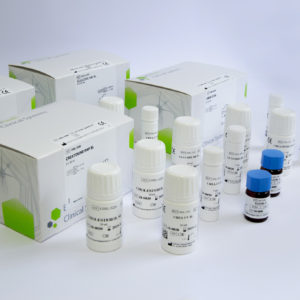Description
INTENDED USE
ELITech Clinical Systems CREATININE PAP SL is intended for the quantitative in vitro diagnostic determination of creatinine in human samples of serum, plasma and urine.
CLINICAL SIGNIFICANCE
Creatinine is the waste spontaneous product of creatine metabolism. It is an excellent marker of the renal function. The serum creatinine rate tends to remain constant. A high serum creatinine rate (associated to a high urea rate) corresponds to a decrease in renal glomerular filtration (FGR). The serum creatinine test is more reliable than the urea test. Indeed, the urea serum rate is affected by factors such as diet, dehydratation degree and protein metabolism (the serum creatinine rate is not influenced by these factors). The test of creatinine clearance can also be used to measure the FGR. In the case of renal transplantation, any increase in serum creatinine, as little as it may be, can reflect the rejection of the trans- plant. An increase of creatinine in serum and urine can be the sign of muscular necrosis.
METHOD
Enzymatic – Colorimetric – Kinetic.
REAGENT COMPOSITION
Reagent 1 : R1
MOPS buffer, pH 7.5
EHSPT 0.4 mmol/L
Creatinase ≥ 10 000 U/L
Sarcosine Oxidase ≥ 3 500 U/L
Ascorbate Oxidase ≥ 1 000 U/L
Reagent 2 : R2
MOPS buffer, pH 7.5
Amino-4-Antipyrine 2.95 mmol/L
Creatininase ≥ 150 000 U/L
Peroxidase ≥ 4 000 U/L
Sodium azide < 0.1 %
MATERIALS REQUIRED BUT NOT PROVIDED
- CALI-0550 ELICAL 2 4 x 3 mL
- CONT-0060 ELITROL I 10 x 5 mL
- CONT-0160 ELITROL II 10 x 5 mL
- Normal saline solution (NaCl 9 g/L)
- General Laboratory equipment.
- Do not use materials that are not required as indicated above.
DAMAGED PACKAGING
Do not use the reagent if the damages of packaging might have an effect on the product performance (leak- ages, pierced vial).
SAMPLES
Specimen
- Serum or lithium heparinized plasma free from hemolysis.
- 24h-Urine to be diluted 1:20 with saline solution NaCl 9 g/L. For users with Selectra Touch Pro software, pre- dilution is performed automatically. Results take the dilution into account.
- Do not use other specimens.
-
Warnings and precautions
- According to Good Laboratory Practice, sampling should be performed prior to the administration of drugs. Sampling could lead to false results if performed during or immediately after the administration of some drugs.
- Do not to use acetic acid to stabilize urine samples.
Storage and stability
- Serum and plasma are stable for 7 days at 15-25 °C, 7 days at 2-8 °C and 3 months at -20 °C.
- Urines are stable for 2 days at 15-25 °C, 6 days at 2-8 °C and 6 months at -20 °C.
REFERENCE VALUES
Men Women
Serum, plasma :
0.72 – 1.18 0.55 – 1.02 mg/dL
64 – 104 49 – 90 μmol/L
Urine: 14 – 26 11 – 20 mg/kg/24h*
124 – 230 97 – 177 μmol/kg/24h*



Reviews
There are no reviews yet.